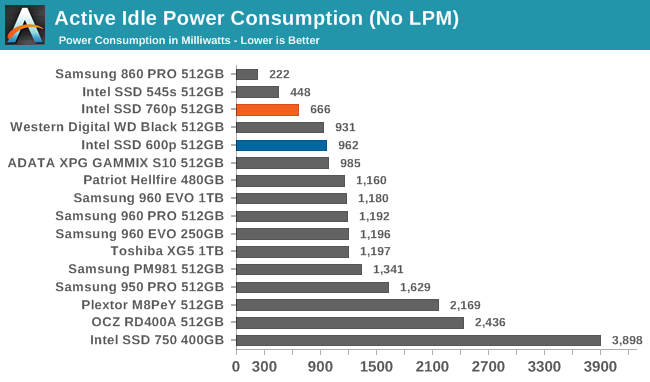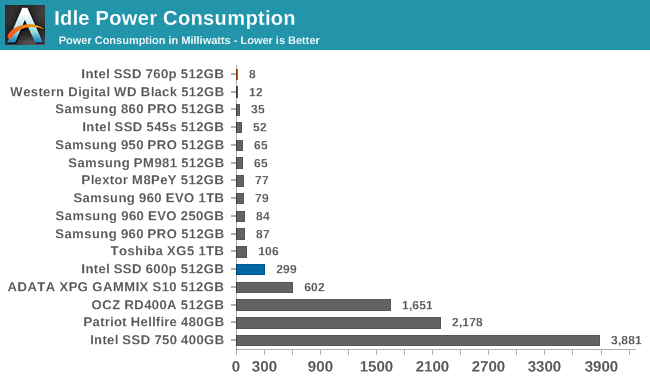The Intel SSD 760p 512GB Review: Mainstream NVMe Done Right
by Billy Tallis on January 23, 2018 11:30 AM ESTPower Management
Real-world client storage workloads leave SSDs idle most of the time, so the active power measurements presented earlier in this review only account for a small part of what determines a drive's suitability for battery-powered use. Especially under light use, the power efficiency of a SSD is determined mostly be how well it can save power when idle.
SATA SSDs are tested with SATA link power management disabled to measure their active idle power draw, and with it enabled for the deeper idle power consumption score and the idle wake-up latency test. Our testbed, like any ordinary desktop system, cannot trigger the deepest DevSleep idle state.
Idle power management for NVMe SSDs is far more complicated than for SATA SSDs. NVMe SSDs can support several different idle power states, and through the Autonomous Power State Transition (APST) feature the operating system can set a drive's policy for when to drop down to a lower power state. There is typically a tradeoff in that lower-power states take longer to enter and wake up from, so the choice about what power states to use may differ for desktop and notebooks.
We report two idle power measurements. Active idle is representative of a typical desktop, where none of the advanced PCIe link or NVMe power saving features are enabled and the drive is immediately ready to process new commands. The idle power consumption metric is measured with PCIe Active State Power Management L1.2 state enabled and NVMe APST enabled.


Updated February 1, 2018: The first time we ran the Intel SSD 760p through our idle power tests, it didn't go so well. The active idle power improvement brought by the SM2262 controller was clear, but when all the deeper idle power states were re-enabled the 760p actually started using more power. We haven't been able to fully determine what went wrong with that test run, but further investigation has revealed at least one apparent but minor bug in how the 760p handles the NVMe APST feature.
After turning off APST (and PCIe ASPM) to get the active idle power reading and a baseline for the idle wake-up latency, our test script re-enables APST and ASPM then give the drive a few minutes to settle down into its deepest sleep state before recording the idle power measurement. From what we have observed, this is not sufficient to actually get the 760p to its lowest power level. Enabling PCIe ASPM saves significant power, but the drive remains in power state 0 (active) even after APST is turned back on. The drive doesn't drop down to power states 3 or 4 (idle) until it receives at least one more command, after which it will start using the lower power states.
During ordinary real-world usage, APST will either be off (many desktops) or on (most laptops) full-time, and this particular bug would never be triggered even momentarily. To work around this bug, we've adjusted the idle power test scripts to poke the drive with one extra command after re-enabling APST, and that has resulted in the 760p setting a new record for PCIe SSD power savings. Since we haven't re-tested all of our M.2 PCIe SSDs with our new Quarch programmable power module yet, we aren't 100% certain that the 760p is the lowest-power NVMe drive out there, but it looks likely. The deepest idle state of the 760p also compares favorably against 2.5" SATA SSD in slumber state, the deepest achievable on desktop systems. SATA SSDs in laptops that can make use of the DEVSLEEP state may beat the 760p's deepest idle state, but we aren't set up to measure that.

The excellent power savings in the deepest idle state provided by the Intel SSD 760p comes at the cost of a relatively sluggish 60ms wake-up latency. The 760p is still much quicker to wake up than the 600p was, and it is worth keeping in mind that not every transition out of idle will be this slow—the 760p has an intermediate idle state where it draws about 31mW and wakes up 1.8ms. During shorter idle periods, the 760p will be in this intermediate state that still offers an excellent balance of power and performance.










51 Comments
View All Comments
Dr. Swag - Tuesday, January 23, 2018 - link
What happened to your performance consistency tests?ImSpartacus - Wednesday, January 24, 2018 - link
I'm glad I wasn't the only one that noticed them missing.I'd love to get a comment on why that is omitted.
SleepyFE - Saturday, January 27, 2018 - link
Just assume it's not consistent enough to measure up. It is an Intel product after all. If they don't won't it published it won't be.jjj - Tuesday, January 23, 2018 - link
Fair perf for the price but not exciting.Any word on a timing for their lower end 660p QLC based drive?
HStewart - Tuesday, January 23, 2018 - link
So this does not used Micron memory, I remember reading that Intel stop work with Micron - maybe this is part of it.This is aim and price at lower end market - and came out at same time as the 860, maybe Intel has a faster one coming later this year. If so that is actually very smart on Intel's part.
edzieba - Tuesday, January 23, 2018 - link
The Micron logo is printed right there on the packages for all to see...emvonline - Tuesday, January 23, 2018 - link
thats dramHStewart - Tuesday, January 23, 2018 - link
Yes - I see that but did Intel designed the memory - also a lot of times company purchase other products in there own products - Intel has done this with AMD GPU's because it feels a hole with discrete GPU until they can provide a replacement.msabercr - Tuesday, January 23, 2018 - link
All the nand is IMFT, Intel has just also leveraged their own fabs to produce more for themselves. All the nand designs are joint venture.jjj - Tuesday, January 23, 2018 - link
Intel and Micron will stop developing NAND together with their 4th gen, this is the second gen, 3rd gen starts prod in second half of 2018 and 4th gen comes 1 year or more later. So you'll see products with that in 2020.Intel has it's own fab now , producing NAND developed with Micron (and so does Micron ofc) but Intel still has supply agreements (at cost) with Micron and those expire in 2018 and 2019.